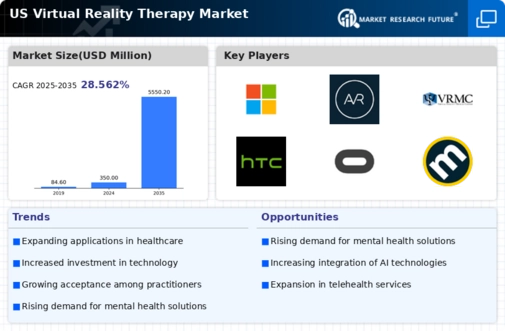The US Virtual Reality Therapy Market has gained significant attention due to the increasing recognition of virtual reality as a therapeutic tool in treating various psychological and physical conditions. This market is characterized by a diverse array of companies participating in the development of innovative VR therapies that cater to mental health disorders, pain management, and physical rehabilitation. The competitive landscape comprises established players as well as emerging startups, each bringing unique approaches to harnessing technology for therapeutic purposes.
Factors such as governmental support for digital health solutions, advancements in VR technology, and rising consumer demand for mental health resources contribute to shaping the market dynamics. As these companies strive to differentiate themselves, key competitive insights emerge around product innovation, partnerships, and strategic market positioning.
Microsoft stands out in the US Virtual Reality Therapy Market as a formidable player due to its robust technological capabilities and extensive experience in creating immersive environments. The company's strength lies in its comprehensive software solutions, which are utilized in various therapeutic applications. Microsoft has leveraged its cloud infrastructure to enhance the scalability and accessibility of VR therapy applications, providing healthcare professionals with the necessary tools to implement effective treatment methodologies. Their commitment to improving patient outcomes through innovative technology is reflected in their partnerships with healthcare providers, enabling them to integrate VR solutions seamlessly into existing therapeutic protocols.
This integration of hardware and software not only enhances patient engagement but also establishes Microsoft's dominance in a rapidly evolving market landscape.
AppliedVR has carved a niche for itself within the US Virtual Reality Therapy Market through its focus on developing evidence-based VR solutions designed specifically for pain management. The company offers a range of therapeutic programs that utilize virtual environments to provide patients with immersive distraction techniques and cognitive behavioral therapy. AppliedVR's strategic presence in the market is marked by collaborations with prominent healthcare institutions and ongoing clinical trials that bolster the efficacy of its products.
The company has shown strengths such as adaptability to varying patient needs and a deep understanding of the healthcare ecosystem, which is vital for successful implementation in clinical settings. In terms of expansion, AppliedVR has been actively pursuing partnerships and has engaged in acquisitions to enhance its technological capabilities and broaden its service offerings, positioning itself as a leader in the VR therapy market focused on improving patient experiences and outcomes across the United States.



















